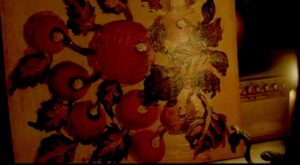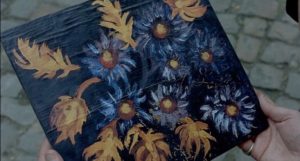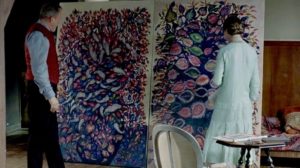Séraphine (2008). Written by Marc Abdelnour and Martin Provost. Directed by Martin Provost. Starring Yolande Moreau and Ulich Tukur. 125 mins. Unrated. Rotten Tomatoes 89%; Metacritic 84%.
She certainly seems not to be the sort from whom one would expect religious wisdom of any sort, and that is true enough, at least at first glimpse. In any case, the odds, at least as we read them, are much against that. A lumbering middle-aged peasant woman, shy and silent, she scrapes by, barely, tending houses and people in a small village not far from Paris. Furthermore, she shows some signs of OCD and apparently for a time lived with the local convent during a period of emotional distress of some kind. Again, nothing singular about her at all.

Save for the oddity that she has lately come to often spend her nights painting, as in still-life painting, and she paints and paints, even devising her own remarkable materials, vivid palette, and curious luminescence (even now, a century later, her paintings retain their haunting chromatic intensity). Beginning with small wooden panels, decades later she paints six-foot canvases of profusely effulgent flowers and trees, stunning in their abstract immediacy. She says her guardian angel told her to paint.
In short, the film tells the story of Séraphine Louis (1864-1942), played marvelously by Yolande Moreau, whose early work was discovered by prominent German art collector Wilhelm Uhde (1874-1947), one of the early sponsors of Picasso and a host of other modernists, a man who saw collecting not as business but as spiritual journey. In 1914, summering outside of Paris in the village of Senlis, he stumbles upon a small, radically unique rendering of apples, and as taken aback as he is to find such a piece, he is further startled when he learns that the panel was, in fact, done by his very own housemaid, a silent and half-decrepit peasant. He soon sees her other work praises and encourages Séraphine.


However, with the fast approach of the German army, he must flee to Germany, leaving behind his own remarkable art collection. In the summer of 1927, he’s back in France staying in Chantilly, nearby to Senlis when he ventures there for a local art fair. Again he is startled by two large paintings, done, unmistakably, by Séraphine, who he assumed had died in the war, and on these he promptly heaps praise, calling them flat-out “very beautiful,” a term he uses only rarely.

The trajectory of this engrossing obscurity-to-fame art tale is indeed remarkable, though the real wonder, frankly, lies in what Séraphine paints, and of this the film could have made more without going didactic. Audiences no more than glimpse her work, whether on the small wood panels on which she begins or the enormous canvasses to which she moves in late career. And in those lies the deep, real wonder, mystery both abundant and, well, dazzling, even when the paintings go “dark.” Throughout Séraphine maintains that what she hears is an angel’s voice, the same that told her to paint in the first place.
We’d think this more than dubious if not for the product, so to speak. And then, too, there’s what she paints and how, namely her relish of a lavish natural world, climbing trees, windy hilltop panoramas, light on river water while bathing, and always endless fruit and flowers.

Throughout, what Séraphine sees, or rather beholds, in those paintings early and late is a world transfigured, aflame with a kind of “fearful symmetry” (William Blake), for lack of a better term, the paintings themselves constitute a raid on the inarticulate and inexpressible (Eliot). So wholly unique and rapturous are they that viewers indeed wonder if she sees as fully and purely as very God the Creator. And hears as well, for throughout her nights of work she sings, often rapturously, from the Mass, convent liturgies, and God knows where, though the neighbors are definitely not at all enamored. In the end viewers sense this peasant woman’s sense of inexpressible splendor in the ordinary, perhaps seeing, against all odds, the world as God sees it: everything transfigured, cells themselves aflame and enchanting, a voluptuous numinous manifest (Dillard).
At one point the film references St. Teresa’s counsel that one can find the majesty of God in the scrubbing of cooking pots. And everywhere else too, and we all can see it as well. Séraphine of Senlis, as she is now known, shows it to be so.
written by Roy Anker
Sign Up for Our Newsletter!
Insights on preaching and sermon ideas, straight to your inbox. Delivered Weekly!
Categorized into Beauty, Creation, Scripture
Séraphine (2008)